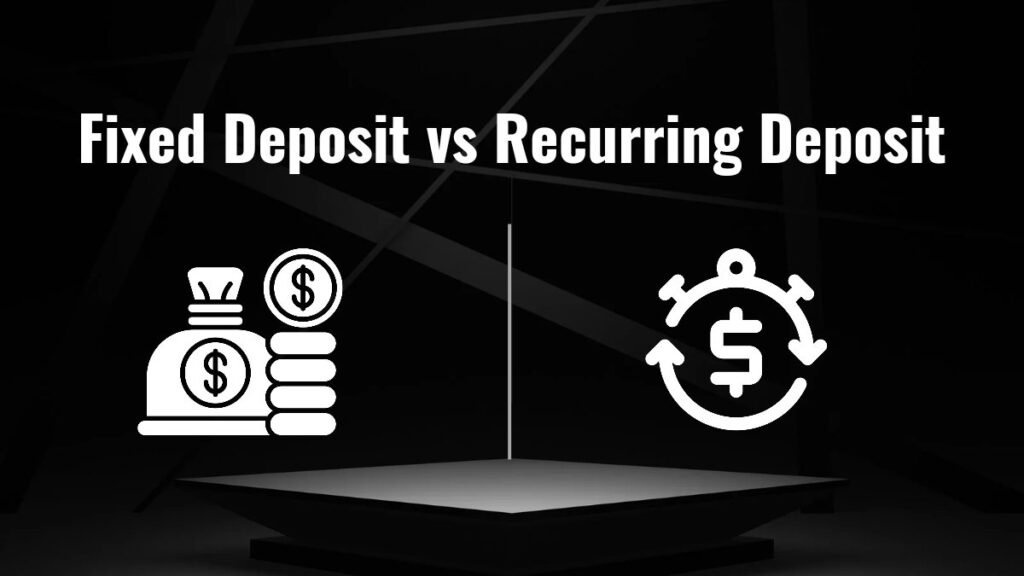Thinking about your financial future? Choosing between a Fixed Deposit (FD) and a Recurring Deposit (RD) can be tough. Both are popular in India and suit different financial needs. But which one is right for you?
Let’s find out together. We’ll look at the details of FDs and RDs. This guide will help you, whether you’re new to investing or have experience. You’ll learn how to choose the best option for your money goals.

We’ll examine what makes FDs and RDs different. This includes interest rates, how long you invest, and how easily you can get your money back. By the end, you’ll know which one fits your needs and risk level. This will help you make a choice that supports your financial dreams.
Understanding Fixed Deposits and Recurring Deposits
Fixed deposits (FDs) and recurring deposits (RDs) are top picks for safe investments in India. They both promise guaranteed returns and protect your capital. Yet, they cater to different needs and risk levels.
A fixed deposit lets you invest a big sum for a set time, from 7 days to 10 years. You decide the interest rate and how long you’ll keep the money in the FD account. FDs are super safe because your money is locked in and you get a fixed return.
Recurring deposits, however, ask you to put in a set amount every month for a fixed time, from 6 months to 10 years. They help build a savings habit by requiring regular payments. At the end, you get back your money plus the interest earned.
| Feature | Fixed Deposit (FD) | Recurring Deposit (RD) |
|---|---|---|
| Investment Type | Lump-sum investment | Regular monthly investment |
| Tenure | 7 days to 10 years | 6 months to 10 years |
| Interest Calculation | Calculated on the entire principal amount over the fixed tenure | Calculated on the reducing balance method, treating each monthly deposit as a new deposit |
| Overall Returns | Higher due to lump-sum investment | Lower due to regular, smaller investments |
| Suitability | Individuals with a lump-sum amount to invest | Individuals with regular income looking to save |
| Risk Profile | Lower risk due to fixed investment amount | Lower risk due to disciplined savings |
| Minimum Investment | Typically starts from Rs. 1000 | Can start from Rs. 50 to Rs. 100 |
Both FDs and RDs offer tax benefits under Section 80C. This makes them great for saving and growing your wealth. Your choice depends on your financial goals, how much risk you’re willing to take, and your savings habits.
Key Differences Between Fixed Deposits and Recurring Deposits
Fixed deposits (FDs) and recurring deposits (RDs) have key differences. These differences affect your investment strategy and financial goals.
FDs require a single, large investment. RDs ask for regular, smaller deposits. This makes RDs better for those who can’t invest a lot at once. FDs are for those with a big sum to invest right away.
The time you can invest also varies. FDs range from 7 days to 10 years. RDs last from 6 months to 10 years.
Interest rates differ too. FDs usually offer higher rates than RDs. This makes FDs more appealing for those seeking high returns.
FDs have harsher penalties for early withdrawal. RDs have softer penalties. This is important if you might need your money before it’s due.
Both can be used as loan collateral, up to 90% of the deposit. But, FDs offer tax benefits under Section 80C of the Income Tax Act. RDs do not.
In short, FDs and RDs differ in investment amount, time, interest, early withdrawal, loan use, and tax benefits. Knowing these differences helps you choose the right investment for your goals and risk level.
Comparison of Returns
Choosing between a fixed deposit (FD) and a recurring deposit (RD) can greatly affect your investment returns. Let’s look at a hypothetical example to understand this better.
Suppose the interest rate is 7.2% per year, compounded monthly. Mr. Jaiswal puts ₹12,000 in an FD for 1 year. He gets a total of ₹12,893. If he puts ₹1,000 each month in an RD for the same time, he gets ₹12,476.
| Investment Option | Maturity Amount (1 Year) | Difference in Returns |
|---|---|---|
| Fixed Deposit (₹12,000) | ₹12,893 | ₹417 |
| Recurring Deposit (₹1,000 per month) | ₹12,476 |
As the time you invest grows, so does the difference in returns. For a 3-year investment, the FD gives ₹3,750 more than the RD.
The main reason for this difference is the compounding effect. FDs benefit more from it because of the large initial investment. Also, FDs usually have higher interest rates, which adds to the returns.
But, don’t just look at the returns when deciding between FDs and RDs. Think about liquidity, your financial goals, and how much risk you can take on.
Conclusion
Fixed Deposits (FDs) and Recurring Deposits (RDs) are top choices in India for safe, secure, and fixed returns. FDs are great for those with a big sum to invest, offering high interest rates and flexible terms. RDs, however, are perfect for building a regular savings habit, needing a set monthly deposit.
When picking between FDs and RDs, think about your investment, how long you want to keep it, the interest rates, how easy it is to get your money, and tax benefits. A mix of both FDs and RDs might be the best way to get the most out of your investments and reach your financial goals.
Both options promise guaranteed returns when they mature, with the interest rate set when you invest. FDs usually have higher interest rates than RDs from small finance banks, but RDs are more liquid. Also, tax-saver FDs with a five-year lock-in period get tax deductions under Section 80C of the Income Tax Act, giving them a tax advantage over RDs.
